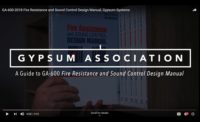In late June, the Gypsum Association took its website to the next level with a complete redesign that offers—among other things—more robust search functionality, new content, and both video tutorials and video FAQs. The redesign included moving to a new server that speeds up the website’s downloading and page loading time.
While updating the look and feel of the website was one motivating factor, more important to GA members and staff was efficiently and effectively providing technical expertise on gypsum panel products. Answering technical questions about gypsum panels and systems is among the Association’s core competencies.
“As the technical center for gypsum panel products, gypsum.org is a resource for a broad spectrum of A/E/C constituencies, including the code officials who ensure the safety of our built environment,” notes Executive Director Steve Meima. “While I can’t imagine a time when the GA will cease to offer a dedicated technical services phone line, at this point in time, not all audiences want to pick up the phone to have their questions answered. Many in the younger generations, especially, expect to easily find answers online.”
The redesign of gypsum.org brings particularly important content to the fore. During hurricane season, for example, all information on removing and replacing drywall after a flood is highlighted on the homepage.
Similarly, ESR-1338, the ICC Evaluation Report that code officials use to verify that building products and installation methods comply with code requirements is more readily accessible. This document is regularly sought out by both architects and construction professionals as a means of demonstrating gypsum systems that are code compliant. When ESR-1338 is requested, it is almost always from the field and in a “need it now” situation. Again, redesign of the website allowed staff to call attention to the Evaluation Report on the homepage providing 24/7, grab-and-go access to this important document.
The GA Library
The new “Publications-At-A-Glance” page was the brain child of Michael Schmeida, the GA’s director of codes, standards and research. “This new addition to gypsum.org groups the entire library of Gypsum Association publications into five categories to make finding publications relevant to any need much easier,” he says. “Concise summaries of the documents provide an overview of each publication.”
Documents are classified under these sections: General Information, Installation and Finishing, Prevention and Repair, Weather Related Considerations, Handling, Storage, and Transportation. Each document description includes a direct link to the GA Bookstore download page for that particular publication. This simple innovation to the traditional manner of presenting GA technical publications saves time for the end user, who can locate the right document and have it in their hand within a few clicks of the mouse.
A long time desire on the part of staff was also realized with the relaunch of the website: Online educational videos. Since hiring Technical and Market Advisor, Greg Woolley, nearly two years ago, Meima had wanted to put Woolley’s education and training in film to work for the GA. As noted in a previous Walls & Ceilings article (“By the Book,” W&C, December 2018), Woolley majored in film at New York University. After graduation, he spent a decade in New York and Hollywood working in film and television. He had the knowledge, but which technical topic was most pertinent and useful, especially in a time when so many voices are competing for attention online?
The introduction of GA-600-2018 Fire Resistance and Sound Control Design Manual late last year led to an obvious choice. Not only is GA-600 the association’s flagship publication, but also the 2018 edition contains new explanatory information on sound control and is organized a bit differently.
GA Video FAQ Series
While the Gypsum Association provides online education centered on GA-600 for members of both the American Institute of Architects and the International Code Council, the hour-long Understanding the GA-600 Fire Resistance and Sound Control Design Manual course does not meet the needs of everyone, particularly those who are not seeking continuing education hours. Watching a guide to GA-600
Fire Resistance and Sound Control
Design Manual entails a commitment of less than 10 minutes. During that brief time, valuable insight is provided on how to use the manual to determine which gypsum system meets the fire resistance and sound control needs of a project.
Additional benefits of the video, according to Woolley are that, “People who learn visually can be intimidated by a text-heavy technical reference book. Also, employees who are new to design and construction may not be as familiar with the formal codes and standards language of the manual.” Moreover, “Every effort was made to ensure that the Guide was produced and filmed so that it can be viewed on hand- held devices such as phones and tablets,” Woolley notes, making the short video easy to fit into busy schedules.
The desire to address more complicated technical questions in plain language and with helpful visual aids inspired the video FAQs. Recorded in podcast style, the first of this series is available now with additional episodes expected to appear shortly. In the first installment, which is hosted by Greg Woolley, Michael Schmeida answers a variety of questions including, how to calculate an R-value, why R-values are important to contemporary construction, why gypsum panels should not be stored or exposed to temperatures in excess of 125 degrees Fahrenheit, and the correct way to layer gypsum panels for inside and outside corners. Within days of posting, a drywall contractor commented on YouTube, “Great video! Learned a lot about some common questions I had.”
The next installment of the GA video FAQ series will address issues around water damage to gypsum panels and replacing panels after flooding—a pertinent topic during the summer months.
New Search Engine Capabilities
One new feature of gypsum.org is a more robust search function. “What are you looking for?” is prominently placed on the homepage. Enter a search term and if the GA has a publication or FAQ specific to that concern, it will display among the results along with any pertinent page content or recent press releases. Enter “sound control” or “acoustics” and the results are a webpage on sound control basics, a press release on GA-600-2018, and the GA history timeline which details when the association began to engage in issues of sound control (1968). Search for a particular GA technical download, either by number or title and the results will include the English, French and Spanish versions of a document.
Two final items on the staff’s wish list for the website may seem a bit contradictory: A more responsive design and better printing capability. While the previous GA site displayed relatively well on a phone or tablet the new website presents an even better appearance on handheld devices. Printing a page from a website seems rather old fashion. Yet, the Association’s constituencies often print relevant webpages to include in submissions to code officials or to clarify issues with other members of the design and construction team. Printing from the old site was problematic and often resulted in the printer spewing unwanted pages of links and footer information. Advances in WordPress software made this a relatively quick fix that delighted GA staff and will no doubt be welcomed by many GA audiences.
As the technical center for the application, finishing, and overall use of gypsum panel products, the Gypsum Association’s website has increasingly become a primary means of serving our constituencies in the design, construction and code communities. The GA hopes you will find the redesigned gypsum.org more responsive to your needs and even easier to use. W&C








Report Abusive Comment